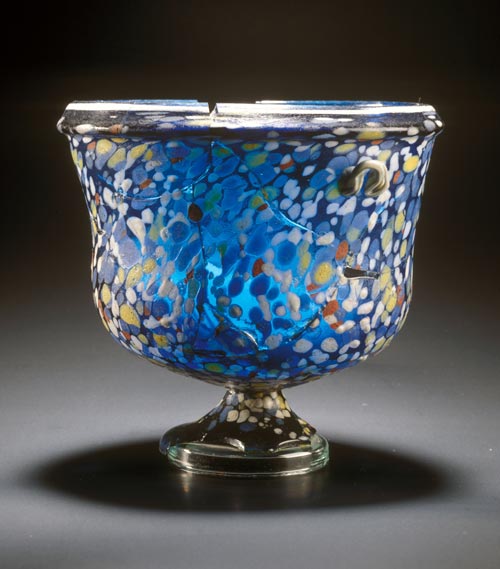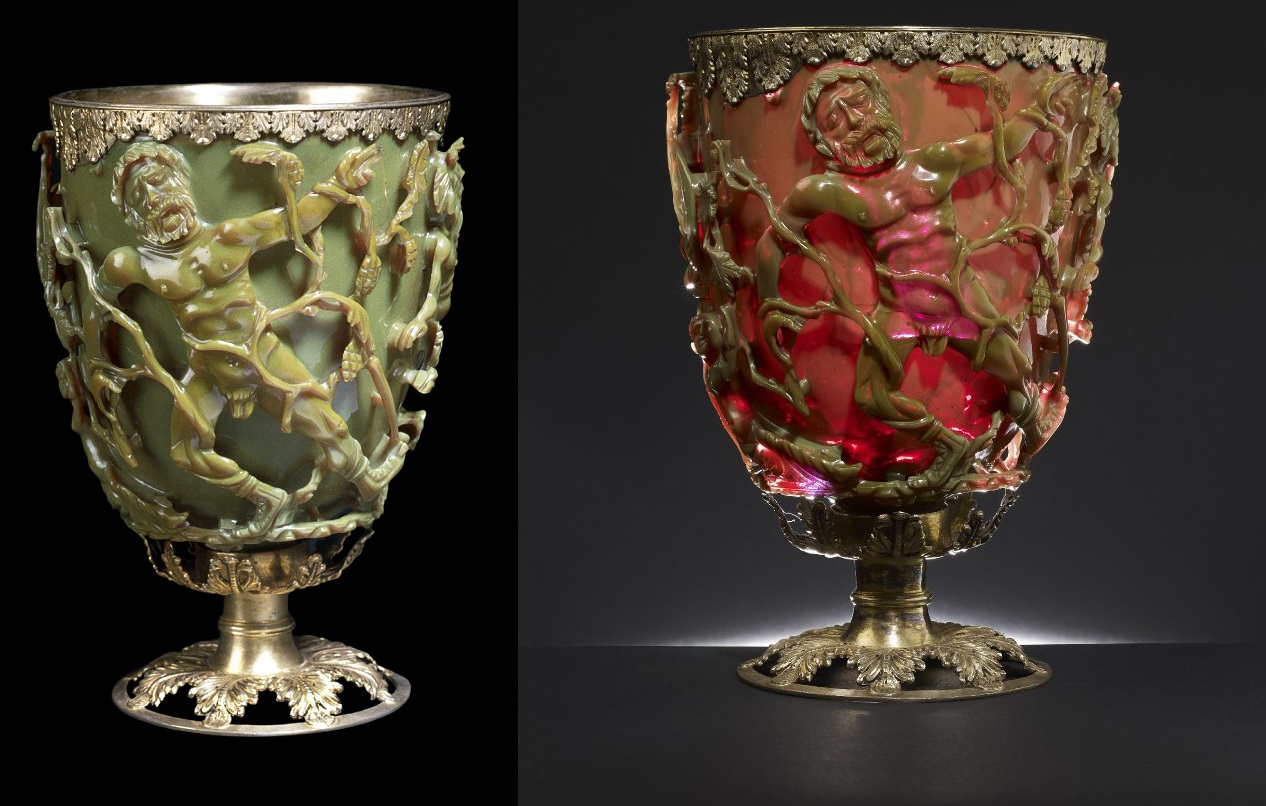Roman glass is found all over the Roman Empire, but how different is it?
Introduction
A few examples of portraits from the later empire have survived which were painted onto glass, some of which are considered very realistic.
- Roman glass is found all over the Roman Empire, but how different is it?
- Are there different styles of glass art?
- Were there any lasting innovations from Roman glass art?
The volcanic glass obsidian was used by Palaeolithic peoples as a cutting material, but the technique of actually making glass probably started in northern Syria as a by-product of making metals. Small glass beads were produced and have been found as far back as the Bronze Age. Glass was known to the Egyptians but the Greeks developed the making of glass. The word glass (Latin glesum) developed in the Roman Empire possibly at Trier (now in modern Germany).
Early Roman glass was produced by ‘slumping’, a technique in which items are made in a kiln by means of shaping glass over moulds at high temperatures. Shaping a glass sheet over a core or former could be used to produce open vessels, such as bowls and plates. The result was a vessel with rough surfaces, which would be ground or polished to a smooth finish. Pillar-moulded bowls utilised a slotted tool to impress ribs on the glass sheet prior to slumping. The result was a bowl with a ribbed exterior, which was polished and sometimes cut with horizontal lines on the inside for further decoration.
Ancient Roman glass can be classified as soda-lime glass. It was made from silicon, sodium and calcium oxides, with the addition of potassium, magnesium and aluminium oxides. In some Roman glass there’s a characteristic pale blue-green colour caused by iron oxide; an impurity.
Links between Roman and modern glass
Modern glass owes much to the Roman glass technology. The principle of making glass relies upon the fusing of two primary ingredients; silica and soda. Yet glass contains much more and archaeological analysis indicates the presence of three possible components:
- Former: This material forms the glass. It is essential to all fired ceramics. The primary glass-former at all temperatures is silica, During the Roman period this was sand (quartz), which contained alumina (typically 2.5%) and lime (about 8%). The alumina contents vary, from around 3% in glasses from the western Roman Empire, and lower in glasses from the middle eastern Roman Empire.
- Flux: This ingredient lowers the melting point of the silica to form glass. Analysis of Roman glass has shown soda (sodium carbonate) being used exclusively. In the Roman Empire the major source of soda was natron, a naturally occurring salt found in dry lake beds around Wadi El Natrun, Egypt.
- Stabiliser: Glasses made from silica and soda is naturally soluble. To reduce the solubility a stabiliser, such as lime or magnesia, is added. In the Roman Period, lime as shell particles were integral to the sand component.
- In some glasses other things were added to make the glass opaque or to colour it (see Table 1).
Table 1: Chemistry of some different Roman glasses
| Roman glass type | Colourante | Content | Comment | Furnace chemistry |
| ‘Aqua’ | Iron (II) oxide (FeO) | ‘Aqua’ glass was pale blue-green in colour, the common natural colour of untreated and early glass. | ||
| Colourless | Iron (III) oxide (Haematite, Fe2O3) | Colourless glass was produced by adding either antimony or manganese oxide. This oxidised iron (II) oxide to iron (III) oxide, which although yellow is much weaker as a colourant, so appears colourless. The use of manganese as a decolourant was a Roman invention first noted in the Imperial period. Prior to this, antimony-rich minerals were used; however antimony acts as a stronger decolourant than manganese, producing a more truly colourless glass. In Italy and northern Europe antimony, or a mixture of antimony and manganese, continued to be used well into the 3rd century. | ||
| Amber | Iron-sulfur compounds |
0.2%-1.4% S, 0.3% Fe |
Sulphur was likely to have entered as a contaminant of natron, producing a green tinge. The formation of iron-sulfur compounds produces an amber colour. | Reducing |
| Purple | Manganese (such as Pyrolusite, MnO2) | around 3% | Oxidising | |
| Blue and green | Copper | 2%-13% | The aqua shade intensified with the addition of copper. During the Roman period this was derived from the recovery of oxide scale from scrap copper when heated. Copper produced a translucent blue glass moving towards a darker and denser green. | Oxidising |
| Dark green | Lead | By adding lead, the green colour produced by copper could be darkened. | ||
| Royal blue to navy | Cobalt | 0.1% | Cobalt gives an intense blue colouration. | |
| Powder blue | Egyptian blue | |||
| Opaque red to brown (Pliny’s Haematinum - blood porphyry) | Copper and Lead |
>10% Cu, 1%-20% Pb |
Under strongly reducing conditions, copper present in the glass will precipitate in the matrix as brown to blood red coloured copper (I) oxide (Cu2O). Lead helps precipitation and brilliance. The red is rare, but known to have been produced during 4th, 5th and later centuries. | Strongly reducing |
| White | Antimony (such as stibnite Sb2S3) | 1-10% | Antimony reacts with lime in the glass matrix to precipitate calcium antimonite crystals creating white with high opacity. | Oxidising |
| Yellow | Antimony and lead (such as bindheimite Pb2Sb2O6(O,OH)) | The yellow colour is caused by the precipitation of opaque yellow lead pyroantimonate (Pb2Sb2O7). Yellow rarely appears alone in Roman glass, but it was used for the mosaic and polychrome pieces. |
Advent of glass blowing
Around the 1st century BCE, during the spread of the Roman Empire through the near east and Egypt, there was a great innovation - that of glass blowing. The migration of people skilled in glass-working enabled the rapid spread of glassblowing techniques across the Roman Empire. It allowed greater flexibility and increased the speed of production. This made glass items competitive with pottery items, leading to a higher degree of artistic freedom. It led to the mass production of this luxury material to imitate precious metal vessels.
Most glass vessels found in the Roman colonies in the British Isles were likely to have been imported from other areas of the Roman Empire. Despite its fragility enough fragments have been found at Roman sites to allow art historians and archaeologists to develop an insight into Roman glass.
Patterns in Roman glass
The Roman glass workers worked with six primary patterns:
- Floral (millefiori) and spiral patterns: The floral patterns were produced by binding rods of coloured glass together, heating and fusing them into single pieces which were then cut in cross-section. The discs could be fused together to create complex patterns. Similarly, spiral patterns were produced using two strips of contrasting-coloured glass alternately fused together and wound round a glass rod while still hot. The rods were cut in cross-section, and the discs fused together to form a plate or plain glass.

Figure 1: Millefiori Roman cup
Image courtesy of Wikipedia / City museum of Ljubljana
- Marbled and dappled patterns: Some patterns were distorted during the melting in the slumping of the glass plate. Using spiral and circular patterns of alternating colours producers could imitate the natural patterns seen in stones such as the quartz sardonyx.

Figure 2: Roman Marbled glass
The Metropolitan Museum of Art, Theodore M. Davis Collection, Bequest of Theodore M. Davis, 1915. www.metmuseum.org
- Lace patterns: Strips of coloured glass were twisted with a contrasting coloured thread of glass before being fused together.
- Striped patterns: lengths of monochrome and lacework glass were fused together to create vivid striped designs, a technique developed from lace patterns.
Many of these techniques can still be seen in high-class glass objects such as those found on the Venetian island of Murano, famed for its glass works.
Vitreous enamelling
Vitreous enamel is a material made by fusing powdered glass to a substrate by firing, usually between 750 and 850°C. In this process the powdered glass is placed on the glass or metal inside a restraining structure, or on a freehand drawing incised on to the glass. The enamel powder was either powdered coloured glass or colourless glass mixed with a coloured pigment. It is then heated so the powder melts and flows to fill the restraining structure. The temperature is important when enamelling glass since the artist does not want the glass to melt as well. It is allowed to cool slowly and it forms a hard, smooth, durable glass coating. The Romans used to decorate glass by enamelling.
Another technique used by glass workers was to sandwich glass with a design painted on it between two pieces of fused glass known as gold glass. This had been used by the Greeks but was developed by the Romans to create markers for graves in the Catacombs of Rome. The majority are Christian and come from the 4th century CE though there are some pagan and Jewish examples. The technique was also used to create gold tesserae for religious mosaics.
The case of the Lycurgus Cup
It has been noted by scientists working in museums that the Romans fashioned their glass ware in such a way they could be described as nanotechnologists. For example, studies on the Roman chalice known as the Lycurgus Cup at the British Museum has indicated it could be the key to a new technology that might help diagnose human disease or pinpoint biohazards at security checkpoints (Smithsonian magazine, September 2013).
The glass chalice, known as the Lycurgus Cup because it bears a scene involving King Lycurgus of Thrace, appears jade green when lit from the front but blood-red when lit from behind.

The Lycurgus Cup.
© The Trustees of the British Museum
This special property puzzled scientists for decades after the museum acquired the cup in the 1950s. The mystery wasn’t solved until 1990, when researchers in England scrutinised broken fragments under a microscope and discovered that the Roman artisans were nanotechnology pioneers.
The glass-maker had impregnated the glass with particles of silver and gold, ground down until they were as small as 50 nanometres in diameter, less than one-thousandth the size of a grain of table salt. The exact mixture of the precious metals suggests the Romans knew what they were doing.
When hit with light, electrons belonging to the metal flecks vibrate in ways that alter the colour depending on the observer’s position. Modern home pregnancy tests exploit a similar nano-based phenomenon to turn a white line pink.
If you would like more information then see the BBC Radio 4 Podcast - Science of Glass.
Downloads
Roman glass and its chemistry
PDF, Size 0.19 mb

















